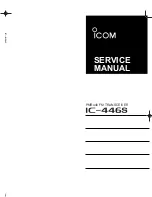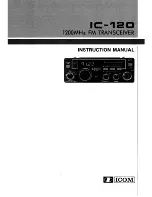
12
Circuit Description
TX/RX switch
D1031
(
MC2848
), then amplified by
Q1043
(
2SC3356
) and
Q1047
(
2SK2973
), then applied to the
power amplifier
Q1052
which increases the signal level
up to 5 watts output power.
The transmit signal then passes through the antenna
switch
D1037
(
RLS135
), and is low-pass filtered to sup-
press away harmonic spurious radiation before delivery
to the antenna.
Automatic Transmit Power Control
RF power output from the final amplifier is sampled
by C1241/C1244 and is rectified by
D1040
(
HSM88WA
).
The resulting DC voltage passes through the Automatic
Power Controller
Q1005
(
NJM2902V
) to the APC attenu-
ator
D1015
(
RN739F
), and final amplifier
Q1052
(
2SK2974
), so as to control the power output.
Transmit Inhibit
When the transmit PLL is unlocked, pin 7 of PLL chip
Q1032
(
MB15A01PFV1
) goes to a logic low. The result-
ing DC “unlock” control voltage is switches off TX inhibit
switches
Q1035
(
2SA1602A
),
Q1037
(
UMW1
), and
Q1041
(
DTA143EU
) to disable the supply voltage to transmitter
RF amplifier
Q1043
, disabling the transmitter.
Spurious Suppression
Generation of spurious products by the transmitter is
minimized by the fundamental carrier frequency being
equal to the final transmitting frequency. Additional har-
monic suppression is provided by a low-pass filter con-
sisting of L1024, L1026, & L1030 and C1242, C1245, C1247,
C1249, C1252, & C1257, resulting in more than 60 dB of
harmonic suppression prior to delivery of the RF signal
to the antenna.
PLL Frequency Synthesizer
PLL circuitry consists of VCO
Q1023
(
2SC5226
), VCO
buffer
Q1029
&
Q1036
(both
2SC5226
), and PLL sub-
system IC
Q1032
(
MB15A01PFV1
), which contains a ref-
erence divider, serial-to-parallel data latch, programma-
ble divider, phase comparator and charge pump.
Stability is maintained by a regulated 3.5 V supply via
Q1030
(
S-81235SGUP-DQI
) which feeds the PLL refer-
ence oscillator
Q1045
(
2SC4116GR
), as well as capacitors
associated with the 17.475 MHz frequency reference crys-
tal X1002.
In the receive mode, VCO
Q1023
oscillates between
143.4 and 172.4 MHz. The VCO output is buffered by
Q1029
and
Q1036
, and applied to the prescaler section of
Q1032
. There the VCO signal is divided by 64 or 65, ac-
cording to a control signal from the data latch section of
Q1032
, before being applied to the programmable divid-
er section of
Q1032
. The data latch section of
Q1032
also
receives serial dividing data from the microprocessor
Q1014
(
M38254M6
), which causes the pre-divided VCO
signal to be further divided in the programmable divider
section, depending upon the desired receive frequency,
so as to produce a 5 kHz derivative of the current VCO
frequency.
Meanwhile, the reference divider section of
Q1032
di-
vides the 17.475 MHz crystal reference from the reference
oscillator
Q1045
by 3495 to produce the 5 kHz loop refer-
ence. The 5 kHz signal from the programmable divider
(derived from the VCO) and that derived from the refer-
ence oscillator are applied to the phase detector section of
Q1032
, which produces a pulsed output with pulse dura-
tion depending on the phase difference between the in-
put signals. This pulse train is filtered to DC and returned
to the varactor
D1015
(
HVC350B
).
Changes in the level of the DC voltage applied to the
varactors affect the reactance in the tank circuit of the VCO,
changing the oscillating frequency of the VCO according
to the phase difference between the signals derived from
the VCO and the crystal reference oscillator. The VCO is
thus phase-locked to the crystal reference oscillator.
The output of the VCO
Q1023
is buffered by
Q1029
before application to the 1st mixer, as described previous-
ly.
For transmission, the VCO
Q1023
oscillates between
118 and 137 MHz. The remainder of the PLL circuitry is
shared with the receiver. However, the dividing data from
the microprocessor is such that the VCO frequency is at
the actual transmit frequency (rather than offset for IFs,
as in the receiving case).
Receive and transmit buses select which VCO is made
active by
Q1021
(
RT1N241M
). FET
Q1042
(
2SK880GR
)
buffers the VCV line for application to the tracking band-
pass filters in the receiver front end.
When the power saving feature is active, the micro-
processor periodically signals to the PLL IC
Q1032
to con-
serve power, and to shorten lock-up time.
Summary of Contents for VXA-150
Page 8: ...8 Notes ...
Page 10: ...10 Block Diagram ...
Page 16: ...16 Note ...
Page 18: ...MAIN Unit Note 18 ...













































